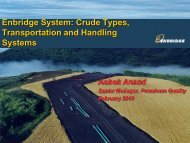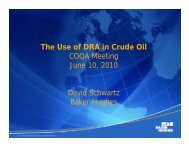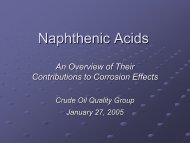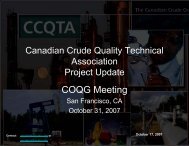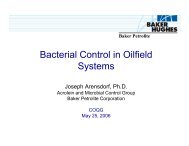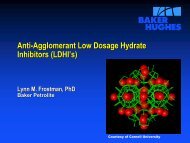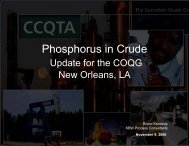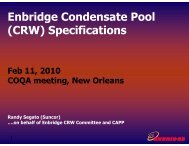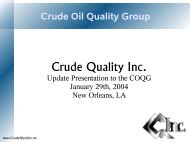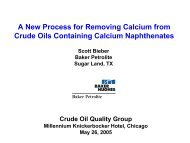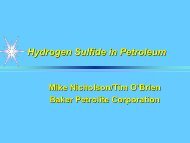SULFA-CHECK⢠Hydrogen Sulfide Abatement - Coqa-inc.org
SULFA-CHECK⢠Hydrogen Sulfide Abatement - Coqa-inc.org
SULFA-CHECK⢠Hydrogen Sulfide Abatement - Coqa-inc.org
- No tags were found...
Create successful ePaper yourself
Turn your PDF publications into a flip-book with our unique Google optimized e-Paper software.
Nalco’s Worldwide ExperienceSour Crude and Crude Slates• Extensive field experience– Africa (Kuito)– Arabia (Qatar Marine)– China (Liuhua)– Russia (Urals)– Latin America (Hamaca)– Mexico (Maya)– Middle East (Brega)– United States (ANS)• Experience with high H 2 S crude oils such as Arab Light/Heavy,Basra, Eocene, Orion and Olmeca used in various crude slates© Copyright 2005 Nalco Company. All rights reservedENERGY SERVICES
Nalco’s Worldwide ExperienceApplications within the Industry• Crude oil production– Offshore: Floating Production Storage and Off-Loading– Oil field: Producing Wells• Outside the refinery– Marine terminals– Oil Traders and Brokers– Pipeline network leading to refinery• In the Refinery– Tank farms– In process• Non-Traditional– Strategic Petroleum Reserves© Copyright 2005 Nalco Company. All rights reservedENERGY SERVICES
Sensitization of the MarketOff-Spec Cargos• Cargos refused – Resulting intraders <strong>inc</strong>urring significantlosses due to delays in productacceptance and demurrage costs• Testing – Requires monitoringand testing to meet target liquidor vapor phase H 2Sspecifications• Tanker Treats -Treated duringloading or off-loading operationsat the wharf or off-shore• Tank Treats – Chemical injectioninto rundown line to and fromtankage© Copyright 2005 Nalco Company. All rights reservedENERGY SERVICES
Sensitization of the MarketTreating with Amine Scavengers• Typically, amine based scavengers are used to abate H 2S from sourcrude oil• On the refining side, processing treated crude oils has led to:– Observed <strong>inc</strong>reases in pH in crude unit overhead water– At one location, reported pressure drop in the overhead pumparound system– Separate location, monoethanolamine (MEA) found entrained in toppump around strainer deposit• Formation of amine salts– Potentially leading to overhead corrosion issues• Depending on amine type– Amine may carryover to a side cut in the atmospheric tower– Some amount of amine partitions into desalter effluent© Copyright 2005 Nalco Company. All rights reservedENERGY SERVICES
<strong>Hydrogen</strong> <strong>Sulfide</strong> <strong>Abatement</strong>Common Questions• Why are crude oils contaminated with H 2 S?• How can I measure the H 2 S content?• What is the best H 2 S control program?• How is an H 2 S abatement program applied?© Copyright 2005 Nalco Company. All rights reservedENERGY SERVICES
Why are crude oils contaminated with H 2 S?Liberation of H 2SLow and high sulfur crude oils can generate excessivequantities of H 2 S.• H 2 S is liberated into vapor space by two processes:– Free (dissolved H 2 S)– Thermal degradation of <strong>org</strong>anosulfur compounds (evolvedH 2 S)• Rate of thermal degradation dependent on:– Sulfur compound type– Temperature– Time© Copyright 2005 Nalco Company. All rights reservedENERGY SERVICES
Why are crude oils contaminated with H 2 S?• Mercaptans– Alkyls, Cyclic– AromaticSulfur Distribution in Crude Oil1-PentanethiolSHBenzenethiolSH• <strong>Sulfide</strong>s– Alkyls, Cyclic• Disulfides– Alkyls, Dialkyl– Cyclic, Alkylaryl• Thiophenes– Alkyls, Benzo– Thieno, Dibenzo• Bicyclic sulfides6-ThiaBiCyclo[3,2,1]Octane871SS5SDimethyl <strong>Sulfide</strong>62SDimethyl <strong>Sulfide</strong>51S24 3Thiophene43665774S2-MethylthianeSS2-Methylthiane1S1S3253Benzo 4 [b] Thiopene21-Thiaindan© Copyright 2005 Nalco Company. All rights reservedENERGY SERVICES
Why are crude oils contaminated with H 2 S?H 2S Partitioning into the Vapor Space• H 2 S migrates into the vapor headspace above aconfined crude oil through an equilibration process• Equilibration is dependent on Henry’s Law• The rate at which equilibrium is reached depends ontime, temperature, mixing, and viscosity© Copyright 2005 Nalco Company. All rights reservedENERGY SERVICES
How do I measure the H 2 S content?Vapor and Liquid Phase Test Methods• Vapor Space Determinations– Can Test Method (ASTM D5705 or In-House variations)– Drager or Sensidyne H 2 S detector tubes• Liquid Phase Determinations– Dilute and Purge Method– Strips H 2 S from sample solution© Copyright 2005 Nalco Company. All rights reservedENERGY SERVICES
How do I measure the H 2 S content?Vapor Phase – Can Test MethodRequired Equipment• Drager Bellows Pump• Drager Tubes (1 -200 ppm, 100 -2000 ppm, 0.2 - 7%)• Quart Metal Cans with caps and3/4” mouth• #8 Rubber stopper• Hot water bath or oven© Copyright 2005 Nalco Company. All rights reservedENERGY SERVICES
How do I measure the H 2 S content?Liquid Phase – N 2Purge Test MethodNITROGENSOURCE50 ML/MINNITROGENVENTSTREAMFINEMETERINGVALVEH2S COLLECTEDPRESSUREREGULATORFLOWMETER. ... ..© Copyright 2005 Nalco Company. All rights reservedENERGY SERVICES
What is the best H 2 S control program?Nalco’s Crude Oil H 2 S <strong>Abatement</strong> Technology• <strong>SULFA</strong>-CHECK EC9085A– EC9085A, Patent s<strong>inc</strong>e 1998– Extensively used for sour crude oils– <strong>SULFA</strong>-CHECK alternatives• Injection Technology – NALGUARD Quill:– Patent s<strong>inc</strong>e 1994– Ooptimizes contact and mixing– Maximized absorption capacity improves cost performance -“Economics”• Developing a Sulfa-Check Program requires:– Product screening determines scavenging efficiencies– Monitoring while administering chemical treatment program– Define field treatment effectiveness and optimize feed rates© Copyright 2005 Nalco Company. All rights reservedENERGY SERVICES
Crude Oil – H 2 S Control Options<strong>SULFA</strong>-CHECK Product Line• <strong>SULFA</strong>-CHECK – Proprietary products providing truereaction chemistry• Stoichiometric reaction – Two moles H 2 S per molescavenger• Incorporates H 2 S into scavenging compound• Splits off two moles of amine• Produces thermally stable, oil soluble sulfide derivative• Does not form salts (No acid-base reactions)• No downstream side affects© Copyright 2005 Nalco Company. All rights reservedENERGY SERVICES
Crude Oil – H 2 S Control Options• Fate of <strong>org</strong>anosulfur derivative− Organosulfur derivative is oil soluble− Bp of reaction product is 365 o F (185 o C)− Will find its way to the heavy end of the gasoline distillationrange or light jet fuel fraction− Thermal degradation does not re-liberate H 2S, but formssimple C-S and C-C fragments• Fate of amine<strong>SULFA</strong>-CHECK EC9085A− Partitioning of amine into desalter effluent brine is minimal− Majority of amine will go overhead− Increases the pH of overhead system, 2 – 3 pH units− No overhead corrosion or fouling issues encountered© Copyright 2005 Nalco Company. All rights reservedENERGY SERVICES
What is the best H 2 S Control Program?Nalco Patented Injection Technology• NALGUARD Quill– Stinger across pipe diameter– Install suction side of transferpipe– Utilize inline mixersH 2S SCAVENGERNALGUARD Quill• Properly sized pump– Sufficient capacity– Sufficient discharge pressures– Pulse inhibitorsFlowQuillIn-Line MixerNALGUARD is a registered trademark of Nalco CompanySourCrude© Copyright 2005 Nalco Company. All rights reservedENERGY SERVICES
Case Study – Southern CaliforniaNALGUARD Quill Optimizes Program EfficiencyNALGUARD is a registered trademark of Nalco Company© Copyright 2005 Nalco Company. All rights reservedENERGY SERVICES
The South China Sea – Liuhua CrudeFloating Production Storage & Off-LoadingVapor phase data at 140 o F:SAMPLE TREATMENT DOSAGE INITIAL FINAL AMOUNT PERCENT REACTIONH2S CONC. H2S CONC. CONSUMED REDUCED RATIO1 EC9085A 250 ppm 1200 ppm 40 ppm 1160 ppm 96.7 % 0.22:12 EC9085A 375 ppm 1400 ppm 40 ppm 1360 ppm 97.1 % 0.28:1Liquid phase data at 140 o F:SAMPLE TREATMENT DOSAGE INITIAL FINAL AMOUNT PERCENT REACTIONH2S CONC. H2S CONC. CONSUMED REDUCED RATIO1 EC9085A 250 ppm 39 ppm 16 ppm 23 ppm 59.0 % 11:12 EC9085A 375 ppm 35 ppm 9 ppm 26 ppm 74.0 % 14:1Note: Reaction ratio refers to the ppm of chemical additive required to react with 1 ppm of H 2S inthe either the liquid or vapor phase.© Copyright 2005 Nalco Company. All rights reservedENERGY SERVICES
The South China Sea – Liuhua CrudeFloating Production Storage & Off-LoadingH 2 S ScavengerProduction PlatformFPSOTransporting VesselSAMPLE INITIAL LIQUID H2S INITIAL VAPOR H2S VAPOR/LIQUIDCONCENTRATION CONCENTRATION RATIO1 39 ppm 1200 ppm 31:12 35 ppm 1400 ppm 40:1© Copyright 2005 Nalco Company. All rights reservedENERGY SERVICES
Nalco’s Worldwide Experience• Typical refinery spot treat costs – Mobilization and demobilization <strong>inc</strong>luded‣ Low range: 100 – 300 ppm H 2 S in the vapor headspace− US $0.15 – $0.30/bbl‣ High Range: 700 – 1,000 ppm H 2 S in the vapor headspace− US $0.50 - $0.60/bbl• Permanent installations for continuous treats are generally lower• Oil production treating costs (212,000 BPD) – Projecting ppm H2S in gas phasebased on ppm H2S in the oil phase targeting 0 ppm in the gas phaseppm H2S in OilCost of Treating Sour Crude Oilppm H2S in gas ppm Scavenger US $/bbl50 200 1,000 0.24100 400 2,000 0.49200 800 3,000 0.73© Copyright 2005 Nalco Company. All rights reservedENERGY SERVICES
<strong>SULFA</strong>-CHECK H 2 S <strong>Abatement</strong>Summary• Nalco Energy Services’ Worldwide experience is extensive• H 2 S concentrations vary widely – crude dependent• H 2 S headspace concentrations are influenced by:– Liquid phase concentrations– Thermal decomposition of <strong>org</strong>anosulfur compounds– Time, temperature, and mixing• Test methods available, which reliably determine liquid and vaporphase H 2 S concentrations• Proper product selection, application, monitoring leads to successfulchemical treatment programs at economically attractive costs© Copyright 2005 Nalco Company. All rights reservedENERGY SERVICES



